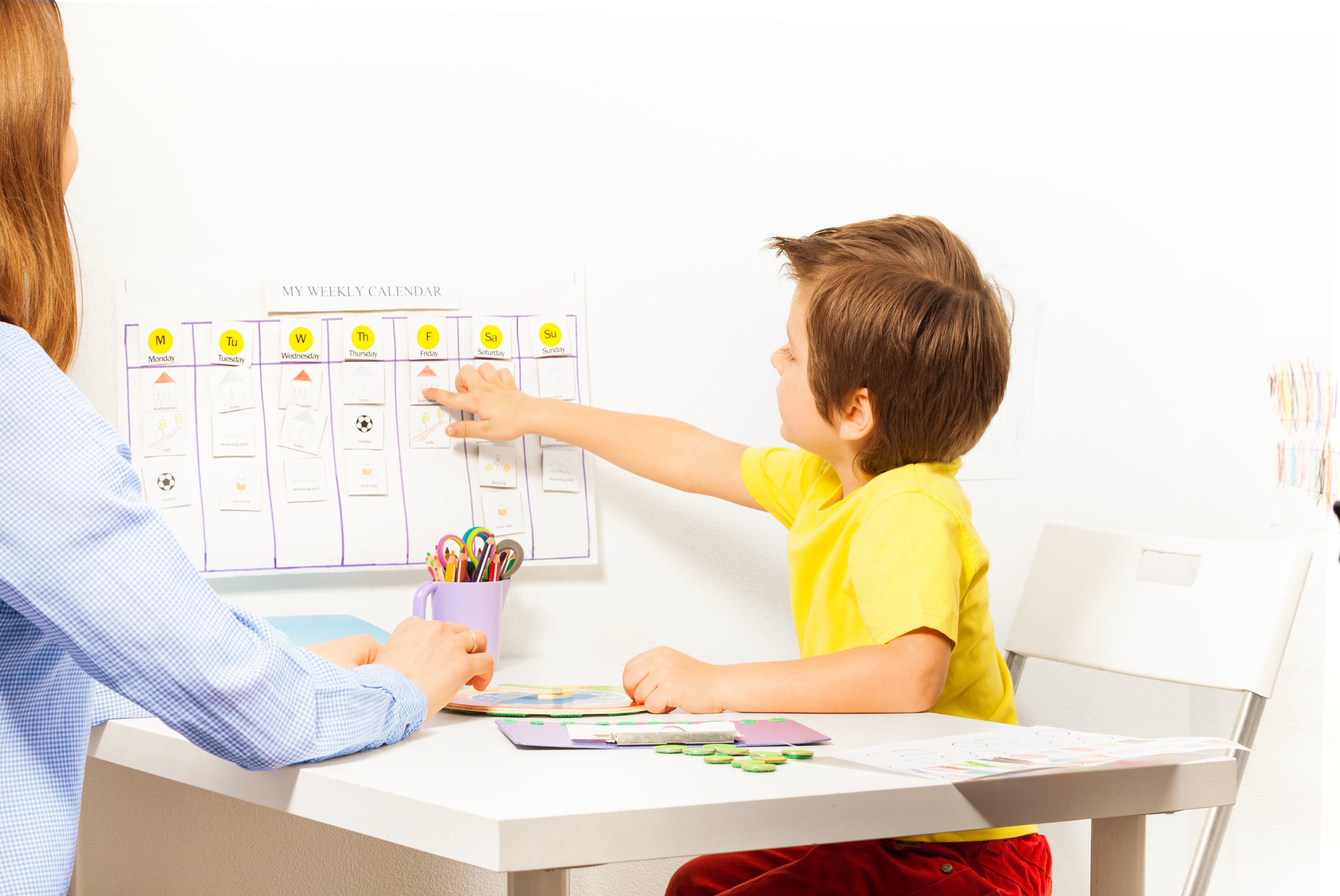Homeschool Makeover: How Can I Make Our Homeschool Less School-y?
Jenn’s been struggling to find a balance between the structure and academics she needs and the fun, laidback vibe she wants her homeschool to have.
Jenn’s been struggling to find a balance between the structure and academics she needs and the fun, laidback vibe she wants her homeschool to have. We help her make some adjustments to make her homeschool more relaxed.
“I love the idea of unschooling, but I’m never going to be an unschooler,” says Jennifer Harris. Jenn homeschools her 9-year-old son Ian in a style that she calls Charlotte Mason-ish—“but lately, it’s feeling like all workbooks and dictation and sitting-at-the-desk time, which is too far in the other direction,” Jenn says.
We asked Jenn to track her time over a couple of weeks so that we could get a clearer idea of what a typical day in her homeschool looked like. Jenn was surprised to discover that she and Ian usually spent about two hours a day on school time—“it feels like so much more,” Jenn says. On most days, they’d start school after breakfast, then sit down together at the table to work. Sometimes Ian would read independently, sometimes Jenn would read aloud, but they’d stay at the table, working their way through one subject at a time, until it was time to start lunch. Jenn’s husband, Frank, comes home for lunch every day, so she and Ian hurry to get the table cleaned up and lunch prepared so that they can all enjoy the meal together.
“It’s gotten to the point where school feels like work to both of us,” says Jenn. “I care about staying on top of things academically, but I hate the way our learning process is starting to feel like a job. Is there a way to bring back fun without sacrificing academics?”
The PLAN
Since it was pretty clear that Jenn wasn’t overdoing it time-wise — two to three hours is a reasonable amount of hands-on school time for a third-grader — we decided to focus on the way she was using her time. By spending all their school time at the table and keeping an eye on the clock ticking toward a lunchtime deadline, Jenn and Ian weren’t able to relax into their routine. Here’s how we changed things up:
Moving classes to the afternoon. When I asked Jenn why they were doing all their school work before lunch, she paused and said, “You know what? I don’t even know.” It turns out that afternoons are quiet at the Harris house. Except for a regular Friday park day, Jenn and Ian are hanging out at home in the afternoons. We suggested moving their second hour of school time to the afternoon to make the morning more relaxed. Instead of jumping into their next lesson after handwriting, Ian starts his independent reading and Jenn gets household stuff out of the way until it’s time to prep lunch.
Starting the day with a meeting at the table. Jenn felt like table time was essential to starting their homeschool day. “I need the structure of sitting down in a consistent spot every day and saying okay, now we’re homeschooling,” Jenn says. We suggested that Jenn keep doing this — but instead of spending an entire morning at the table, she and Ian could get the same down-to-business boost from a morning meeting there right after breakfast. While they’re at the table, Ian does his daily copy work and handwriting practice.
Relocate for different subjects. The kitchen table is the best place for Ian to practice handwriting, but his other subjects might benefit from a change of scene. We suggested that Jenn and Ian switch locations each time they move to a new subject: math on the patio, history on the couch, spelling at the desk in Ian’s room, etc. This kind of musical chairs isn’t just a way to transition between subjects—researchers have discovered that students who work on material in different places retain it better than those who sit in the same spot to study every day.
Integrate more reading aloud. Ian’s a strong reader, and Jenn’s been encouraging him to do more independent reading, but since readalouds are one of the things Jenn and Ian like best about homeschooling, we suggested that they bring back the readaloud. (Kids benefit from being read to long after they’re able to finish chapter books on their own, and reading together means you get to learn together—which is one of the best ways to feel like your homeschool is a fun, relaxed place.) We suggested that Jenn and Ian go back to doing book-based subjects, including history and science, as readalouds and letting Ian keep his reading skills sharp with independent reading.
The results
“I didn’t realize such simple changes could make such a big difference, but they really have,” Jenn says when we follow up with her. She and Ian have been implementing their new routine over the past month, and Jenn says everything is working better than she had hoped.
“I think I bought into the idea that when we hit third grade, school should become more school-like,” Jenn says. “And the result was that Ian was learning about the same amount but we were having a lot less fun. I think I needed someone to say ‘Hey, you can teach your kid what he needs to know and still have fun doing it.’”
This column is excerpted from the summer 2016 issue of HSL. Do you need a homeschool makeover? Email us at hello@homeschoollifemag.com with a description of what’s tripping up your homeschool life, and we may feature your makeover in an upcoming issue.
How Do You Cope When Life Interrupts Your Homeschool?
When the going gets tough, how do you juggle life and homeschooling?
Sometimes life gets in the way of homeschooling — and that’s the way it has to be because homeschooling is part of your life.
This year has been crazy — my mother-in-law was diagnosed with cancer, we had to move unexpectedly, and my husband broke his ankle playing soccer with the kids. To say that homeschooling has gotten short shrift would be a major understatement, and things don’t look to be settling back to normal any time soon. How do you handle homeschooling when life keeps getting in the way?
I’m so sorry you’ve got so much on your plate right now. Maybe it helps a little to know that even though you might sometimes feel like the world’s worst homeschooling parent, everything is going to be okay. Sometimes life gets in the way of homeschooling — and that’s the way it has to be because homeschooling is part of your life.
You don’t say how old your kids are, but if they haven’t started high school yet, give yourself permission to unschool for a while. Instead of trying to make new schedules and hunt for easier-to-use curriculum materials, just stock up on open-ended activities, like math games, puzzle books, art supplies, readalouds, building materials, etc. Have what we call “do something” time each day — kids can choose from a variety of activities you’ve decided on together, and that counts as your school time. They may reread the Harry Potter series, draw a series of still life pictures, or watch math videos on Khan Academy. During this time, be as present as you can be. When you have a lot to deal with, it’s easy to fall into the trap of checking your phone or your email all the time, but try to set aside short blocks of time where you’re just focused on being with your kids. For your own sanity, don’t try to make this active teaching time — just be with them, whether you’re reading together or playing Uno.
If your student is in high school and missing time could affect his transcript, talk about it. He may be fine with adding some lesson time to his summers or waiting an extra year to graduate — neither of which is a big deal. If he’s worried about falling behind, consider signing him up for a semester of online classes. It may not be the first choice for either of you, but if he wants to stay on schedule, it’s a straightforward way to do it.
Check in with yourself regularly to make sure that homeschooling still makes sense for your family. Sending the kids back to school — for a while or for good — isn’t a homeschool failure; sometimes it’s the thing that makes the most sense for your family’s life. It sounds like a lot of your life disruptions will settle down with time, but if you can’t foresee a time or event that would stabilize your everyday life, you might want to consider your options beyond hands-on homeschooling.
Above all, don’t feel guilty. Try to think about how you’d like your children to handle stress, setbacks, and unexpected problems in their own lives, and try to model that behavior. You’d probably want them to take good care of themselves and keep their focus on doing the best they can without beating themselves up about the places where they fall short. Sometimes, following our own advice is the smartest thing we can do.
This Q&A was originally published in the summer 2016 issue of HSL.
How Can I Help My Homeschooler with Test Anxiety?
Testing isn't the most important thing — but when testing creates a lot of stress for your student, a few practical strategies might help him get more comfortable with the process.
It may seem counterintuitive, but one of the best ways to help a test-stressed kid is to give them more opportunities to take tests.
Our state’s homeschool laws are pretty relaxed, but we do have to do a standardized test every three years. This was our first year, and my son had terrible text anxiety — he broke down in tears during the test and couldn’t finish it, and he was upset about it for days. Obviously I want this to go better next time. How can I help him with his text anxiety?
It’s hard to blame anyone for feeling nervous about a test — choosing the right answers from a list of possibilities with a timer ticking in the background is a classic stress scenario. But since most kids will run into a situation where their performance on a test matters — because of homeschool laws, college admissions, or something else — it makes sense to minimize anxiety as much as you can.
One of the best ways to do this is to make testing part of your routine. Even if you’re not required to test every year, having a week of testing on the schedule every year can help a test-anxious kid start to get used to the testing process. Consider starting very slowly, by giving your son one or two test-style questions a week and gradually increasing the number of questions over time. If it’s the timing that stresses him out, let him practice answering a question with a five-minute time limit and gradually reduce the time so that he’s answering questions more quickly. Testing is a learned skill, and like any skill, it takes practice and patience to develop.
Kids with test anxiety also benefit from familiarity with the test style and format. Homeschoolers, especially, aren’t always accustomed to answering A, B, C, or D to questions that are sometimes deliberately tricky. Order a test booklet online (Seton Testing has affordable versions), and let him just flip through it, looking at the questions and getting comfortable with the idea of the test.
Tests don’t really measure intelligence, knowledge, or ability, and it’s important to help your child understand that. Explain to your son that a test is just a benchmark that shows what you know in a specific area — sometimes you know a lot, and sometimes you don’t know as much. The goal isn’t to get all the right answers but to give an accurate picture of what you know. If you race too quickly for the test or make wild guesses or don’t check your work, you reduce the accuracy of the test — so you do want to do your best, but you don’t need to worry too long over questions that you can’t answer.
Building familiarity is a slow process, but it’s the most effective way to ease anxiety about tests. Don’t fret, though, if your child never totally relaxes behind the number-two pencil. Testing can be anxiety-inducing for some people, and your son’s score on standardized tests may never be a perfect reflection of his knowledge. But with slow and steady practice, he can get comfortable enough to get through a test successfully — and his grades, essays, and other achievements will help give a well-rounded picture of his academic experience (link to Patreon podcast).
This Q&A is reprinted from the spring 2017 issue of HSL. We answer reader questions about homeschooling in every issue; you can email your questions to hello@homeschoollifemag.com.
Q&A: How Do I Deal with the Clique-y Moms in Our Homeschool Group?
We recently found a homeschool group that my kids love. The problem: The moms are super clique-y and not very nice. Is it worth continuing in a group where I’m miserable, even if my kids are happy with it?
We recently found a homeschool group that my kids love. The problem: The moms are super clique-y and not very nice. Is it worth continuing in a group where I’m miserable, even if my kids are happy with it?
Well, the question you need to ask here is, “Does it matter if this group is a good fit for me?” It’s possible that it doesn’t — you may have your own group of friends and a strong support network, and you can view this group as a social outlet that’s just for your kids. In that case, treat it as you would any activity waiting room: Bring a book or catch up on your phone calls or work on a knitting project, and grab a seat where you don’t have to deal directly with the not-so-nice moms. Smile and say “hi” when you arrive, wave “bye” when you head out, and don’t give any of your emotional energy to the situation beyond that.
Of course, it’s perfectly possible that you’re looking for a social outlet for you as well as for your kids. If that’s your situation, you may want to give these moms a second chance before writing them off. It’s possible that you misread their cues on your first outing, and they are really more welcoming than you thought. Sometimes what seems like shutting other people out is really just a group of people being so excited to catch up with each other that they forget there’s a world outside their group. If you jump into the conversation, they may welcome your participation.
If you’re dealing with a real mom clique — and they’re out there — assume that you aren’t the only mom to get the cold shoulder, and look for other parents on the fringe of the group. Strike up a conversation with the mom who always shows up with a book or the dad who spends the hour working on his tablet. And warmly welcome newcomers who show up, like you, hoping to find a piece of their homeschool community in the group. You may discover that the clique is only a small (if salient) part of the overall group.
If your best efforts still leave you feeling lonely and on the outside, it may be that this just isn’t the group for your family — even if your kids seem to enjoy it. New homeschool groups sprout up every year — you could even start one yourself — and finding one that’s a good fit for your clan can take time and effort. Sometimes moving on is the best way to deal with a snooty group of moms.
This Q&A was originally published in the spring 2015 issue of HSL.
How Do You Know When It’s Time to Officially End the School Year for Your Homeschool?
Your official last day of school can be whenever you want—so pick a date that matches your family’s homeschool rhythm (or don’t pick a date and have a year-round homeschool).
Your official last day of school can be whenever you want — so pick a date that matches your family’s homeschool rhythm (or don’t pick a date and have a year-round homeschool).
OK, this may be a stupid question, but how long should our homeschool year be? This is our first year homeschooling, and I’m not sure how to know when it’s time for summer vacation.
I’m actually a terrible person to answer this question — when we started homeschooling (in the middle of my daughter’s 2nd grade year), I was so indecisive about when to stop that we ended up becoming year-round homeschoolers. We just kept going until September rolled back around. It worked, so we’ve been doing it ever since. But maybe that also makes me a good person to answer this question because I can honestly say that you can make your year as long as you want to.
Some states require homeschoolers to log a certain number of learning days each year, so of course you want to make sure that if your state has such a requirement, your homeschool plan meets it. Beyond that legal essential, though, deciding when to declare it summer in your homeschool is up to you.
Some curricula make this easy. When you finish them, you can close up shop and call it a year for math or history. That’s easy if your students generally keep pace with the curriculum, but if your child works faster or slower or if she’s faster in some subjects and slower in others, it can be trickier: If you finish one book in January, it makes sense to start a new one, but what if you finish in April? Or what if it’s August, and you’re still plugging away at history?
It might be simplest to just pick an official date as your “last day of school” — your homeschool’s “last day of school” might match up to the date your local school closes or be the week your pool opens or just be the first day May — and say “This is when our year ends.” Bookmarks go into unfinished curriculum, evaluations get written, and you clean up the school stacks. That doesn’t mean you shut down learning, obviously. Homeschooling is a year-round process, whether you put the books away for the summer or not, but you can set a date to stop doing structured learning time unless a kid specifically requests it.
You can also follow my lead and just keep a casual homeschool going year-round. The benefit to year-round homeschooling is that it’s easy to introduce new books and curricula as they become appropriate, and you always know that you can go as fast or as slow as you want without worrying about a deadline. (The downside is that you miss out on all those “New curriculum!” photos in late summer — though personally, just buying things as we need them has worked out pretty well for me.) A year-round homeschool doesn’t mean you’re always “doing school;” you just spread breaks out through the year, so you might take a month off to watch the Olympics or a week off for birthdays.
However you decide to end your academic year, make sure you pause to celebrate your success. One of my friends makes a cake with her kids to mark the end of the great year; we usually plan a pancakes-and-pool-day fiesta at the end of summer to celebrate starting a new grade. When you decide to start and stop isn’t really important, so if you try something this summer that doesn’t feel right, you can adopt a different practice next year. Just like every other part of homeschooling, knowing how your annual schedule runs is something that you’ll figure out for your family one year at a time.
Why Are Homeschoolers So Flaky?
What if you planned a field trip and nobody showed? For homeschoolers, this happens more often than you might think.
I keep running into the same problem, and I can’t tell if I’m doing something wrong or if homeschoolers really are just super-flaky. Last year, I planned a field trip for our homeschool group to a local science museum. Ten families RSVP-ed “yes” to the event, but when the day of the field trip arrived, only one family showed up. (They hadn’t RSVP-ed at all.) No phone calls or messages to cancel — people just didn't show up. I planned another field trip to an art museum a few weeks ago, and the same thing happened — even though this time I specifically confirmed the field trip with everyone who RSVP-ed. I’m obviously over planning field trips for this particular group, but is there anything I could have done differently to avoid the frustration of flaky homeschoolers?
It’s not just you — planning activities for a homeschool group can be an exercise in frustration, with lots of excited input during the planning stages and low turnout for the actual event. The good news is that plenty of homeschoolers are as fed up with flaky homeschoolers as you are — you just have to find them.
If you want to understand why homeschoolers are prone to last-minute flakiness, Patricia Rosen, etiquette expert, suggests that this kind of flexibility may be a feature of your particular homeschool group. “Once you realize that other people don’t feel obligated to show up for events and activities, it gives you the freedom to just not show up, too,” Rosen says. That can be a good thing for new homeschoolers, who often bite off more than they can chew trying to squeeze in every fun activity that comes their way. It can be reassuring to know that activities come with a no-repercussions opt-out. These homeschoolers are probably genuinely enthusiastic about the activity you’ve planned — but they’re also enthusiastic about lots of other things and may have trouble fitting all of them into their real-life schedule. “A lot of flaky people just plain overestimate what they can actually do in a given day or week,” says psychotherapist Stephen Burglas.
You can’t change a flaky homeschooler’s attitude — though Burglas says some people do improve over time — but you do some things to minimize the frustration factor for yourself. Next time you plan a field trip, collect the admission fees when people RSVP, and you’ll quickly get a sense of the people who are serious about making space for the field trip in their schedule. Make it clear that fees are non-refundable (even if you’re willing to be flexible about refunding money to people who have emergencies or illnesses that keep them from attending). Even if a trip is free, charge a couple of dollars per family. “Getting money involved, even if it’s just a couple of dollars, seems to help people take homeschool commitments more seriously,” says Jeannie Briscomb, who plans field trips for her California homeschool group.
Briscomb says she also regularly prunes people who don’t participate in field trips from her email list and automatically deletes no-shows after the first offense. “A few people have complained, but I point out that I never delete anyone who reaches out to say they aren’t coming — only people who RSVP ‘yes’ and just plain don’t show up,” Briscomb says.
Over time, you’ll probably find a cadre of similarly committed homeschool parents to plan field trips with — you’ll know them because they are the ones who, like you, show up when they say they will. “I plan activities for the whole group, but when I get free admission or discount tickets, there’s a core group of families I email first because I know they’re going to be reliable,” Briscomb says.
What if you’re the flaky homeschooler? Obviously one of the great things about homeschool life is the ability to wake up in the morning and choose the shape of your day as you go — if your kids get excited about backyard bug investigations or pulled into a major Minecraft project, you don’t have to hit the stop button for a field trip or anything else. But if you’re a frequent flaker, be aware that your actions have consequences beyond one particular field trip. Field trip planners who deal with one-too-many flaky parents may stop planning trips entirely, leaving you with fewer extracurricular options when they do fit into your schedule. You may also find that you’re left off some planning lists or event invites because you’re too often a no-show. That doesn’t mean you have to reshape your life around plans that don’t work for your family on a particular day, but it does mean you should avoid getting a reputation as a flake: If you change your mind about a field trip, shoot its organizer an email to let her know. That’s a tiny courtesy on your part that shows that you respect the organizer’s efforts and the inconvenience you might be causing the group by bailing at the last minute.
This Q&A was originally published in the winter 2018 issue of HSL.
How Can I Find Friends for My Middle Grades Homeschooler?
My middle schooler’s homeschool community is shrinking right as friends are more important to her than ever, and it’s taking a toll on our homeschool happiness. What can we do?
My middle schooler’s homeschool community is shrinking right as friends are more important to her than ever, and it’s taking a toll on our homeschool happiness. What can we do?
Q: Homeschooling has been a great fit for us for a few years now, but this year, I feel like I’m failing. My daughter is in 6th grade this year, and a lot of our regular homeschool friends have gone back to more traditional schools. Park days are all younger kids, and lots of classes at our co-op that she’s interested in don’t get enough students to meet their minimums. At the same time, her old friends are busy with school and hard to connect with — when I’m actively planning, we can sometimes get a sleepover together, but they rarely think to invite my daughter to anything. She’s lonely and sad and talking about going to school be- cause she misses her friends. Is there anything I can do to fix this?
A: We homeschoolers roll our eyes when people talk about socialization, but we don’t always talk about the other side of that. Sure, our kids are not unsocialized freaks because they’re out in the world, chatting with other human beings and doing normal human things, but it can be hard to make friends as a homeschooler. Some of us luck into great homeschool groups with a lot of locals in easy driving distance, but most of us find the whole friend thing challenging, especially as kids get older. Ironically, that’s also when having friends — not just friendly acquaintances — become especially important for our kids.
Knowing that you’re not alone in this may help a little, but what you really want are solutions. One might be to extend your net: It is common to age out of homeschool groups as time passes. Statistically, more people homeschool elementary school than middle school, and the numbers drop even more as you get to high school. Other people are probably in the same boat you are — they just may not be people in your usual circle. Remember how when you started homeschooling you reached out on social media to find other homeschoolers and went to every homeschool day you could? Do that again. Take a class at that group for older kids, even though you don’t know anyone there and you're not sold on the curriculum. Take all those chances you took at the beginning, when you were committed to building a community.
If you have space — or can make space — it might also be worth trying to organize some events for older homeschoolers yourself. This is usually a high-effort, low-reward project, but you don’t need a big reward for it to be successful — you’re just looking for a handful of kids to hang out with. If one or two people show up, you’re doing well.
This is also a good time to expand your community beyond the homeschool world. If you have a tween who loves animals, volunteer at a pet shelter. If you’re interested in costumes or drama, get involved with a community theater group. Love math? Lots of universities host weekend math circles. If you live in an area where homeschoolers can take public school classes or activities, this might be a good time to try those out. The idea is to connect your child with opportunities to meet like-minded kids, whatever they do for school. Friends your child makes through shared interests are more likely to survive the challenge of different schedules than more casual social connections.
If your daughter’s lack of a social life is really frustrating her and none of these solutions yields results after several months, it’s worth considering whether homeschooling is still the right fit for your family. There are lots of reasons we choose to homeschool, but one of them is to deepen and strengthen family relationships — and if your daughter’s unhappiness at missing her friends is wearing on your relationship, consider other academic options. Hybrid schools, charter schools, online classes, or even public school may be the better fit right now if homeschool social opportunities are limited. The best homeschooling is the kind that constantly reevaluates itself to make sure it’s giving kids what they need. In the middle grades, some kids need a lot of social time, and if homeschooling isn’t providing that, it’s okay to look elsewhere for a year or longer. As long as you’re doing what’s in the best interest of you and your student, you’re homeschooling right.
FAQ: How Do We Let a Long-Time Teacher Know We’re Looking for a New Class?
How do you break up with your kid’s teacher?
We’ve been taking piano with a perfectly nice but not amazing teacher for three years now. My son’s interested in taking lessons with one of his friend’s teachers — he’s a young, enthusiastic guy whom the kids adore. I know it’s okay to switch teachers, but do I need to let our long-time teacher know why we’re leaving? We don’t have any problems with her, but my son is really excited about the opportunity to study with another teacher.
Since you’ve been working with this teacher a while, I think it’s probably good manners to give her a little notice that you won’t be continuing lessons. You don’t have to do this, but it’s nice to let her know that there’s a change coming to her regular income stream in case she wants to advertise for new students or contact people on her waiting list. In some cases, you may actually be required to give her a certain amount of notice that you’ll be dropping the class or pay her for a full term of classes — if you signed a contract or payment agreement when you started your lessons, make sure you understand your obligations. You don’t have to go into details — shoot her an email to let her know that your son has enjoyed studying with her, but you won’t be continuing lessons after a specific date. I think a month’s notice is nice to give, but of course you have to do what works best for your family.
When you talk to her, it’s fine to disclose whatever you are comfortable with. (And it’s fine to email her or call her rather than telling her in person.) If you want to keep it simple, you can just say “We really appreciate everything you’ve done for Joe-Bob, but we’re making some changes to our schedule and will be ending our lessons with you after the 5th.” If you want to give more details, go ahead: “Joe-Bob has really enjoyed studying piano with you, but he’s decided he wants to try working with a different teacher. Our last class with you will be the one we have scheduled for the 5th.” If she asks why you’re switching, it’s fine to be vague —“It just seems like a better fit for us right now.” If you had a specific problem — lots of cancellations or a too-gruff teaching manner — it would be fine to let her know, but it sounds like you weren’t unhappy, just ready to move on. Usually in these situations, the best approach to take is the one you’d like someone to take in your position.
How Can I Tell If a Homeschool Group is Really Secular?
We’re new homeschoolers, and we’ve already had a bad experience with a group that turned out to be super-religious when we attended an event. How can we tell in the future if a group is religious or secular?
We’re new homeschoolers, and we’ve already had a bad experience with a group that turned out to be super-religious when we attended an event. How can we tell in the future if a group is religious or secular?
It seems obvious, but the best way to tell whether a group is really secular is just to ask: “We’re secular homeschoolers — is this an inclusive group?” Most group leaders aren’t going to have a problem answering a direct question, and you’ll know right away what the tone of the group is.
If the group leaders avoids or talks around the question, you can push for a specific answer — “Cool, but we will be the only non-religious homeschoolers there?” or “Are there any religious ceremonies, like group prayers, that happen at the park day?” — but avoiding answering is a kind of answer, too.
If you’re uncomfortable asking, it’s worth overcoming your discomfort — it really is the best and most effective way to get the information you are looking for. But if you’re determined not to ask, you can search the messages or posts of the group for words like “Apologia,” “church,” “modesty,” or “pray.” It’s not sure-fire, but it can certainly give you a clue.
How Can I Help My High School Procrastinator?
When procrastination is starting to get in the way of a student’s academic success, your support can make a big difference.
When procrastination is starting to get in the way of a student’s academic success, your support can make a big difference.
You asked: My 15-year-old has always been a procrastinator — he claims he needs the pressure of a deadline to inspire him. I’m sympathetic to that, but now that he’s in high school, waiting until the last minute means he’s turning in sloppy, unfinished work and projects. This is also the first year he’s taken an outside class for grades that “count” on his transcript, and it’s frustrating to see his work not reflecting his abilities. How can I help him stop putting work off until the last possible minute?
When it comes to procrastination, there are basically two kinds: functional and dysfunctional. It sounds like for a lot of his life your son has engaged in functional procrastination — he might put his work off until the last minute, but he’d get it done in the end by putting in a last-minute push. Now, though, he’s hitting high school, where longer —term planning is often required to get work done, and his procrastination has become dysfunctional. He might get the work done on time, but he’s not getting it done well. He knows what he needs to do, but he’s not able to push himself to do it. The work he’s doing has changed, but his method for dealing with it hasn’t—and if his procrastination goes unchecked, you’re right that he’s looking at a lower GPA than his intelligence level might indicate, not to mention increased stress levels and academic anxiety.
The great thing is that you’re recognizing that procrastination is a problem now, while the stakes are fairly low. In a few years, a procrastination habit could mean failing out of college, losing a job or blowing an internship, but right now you have a window when the cost of procrastination is high enough to motivate your student to make some changes but still low enough that he doesn’t have to shoulder major consequences.
The root of procrastination lies in our brain chemistry. People who procrastinate tend to believe that they must be in a good mood to tackle a task they consider uninteresting; when given a choice between two options, who wouldn’t choose the one that seems more fun? Most people will sigh, buckle down, and get to work anyway, but chronic procrastinators keep choosing Option B. For chronic procrastinators, short-term mood repair takes precedence: Chronic procrastinators want to eliminate the negative mood or emotions now, so they give in to feel good. They give in to the impulse to put off the task until another time, explains Tim Pychyl, procrastination researcher at Carleton University and the author of Solving the Procrastination Puzzle. The problem, says Pychyl, is that teens who procrastinate vastly overestimate how much motivation they actually need to do something. It may be hard to work up the motivation to write an entire essay, but you don’t need a lot of motivation to make a list of sources for an essay.
In other words, the key to beating procrastination is to break tasks down into parts so small and specific that your student can feel totally confident he’ll be able to succeed in them. The easiest way to do this is to help him figure out how to focus on time — say “let’s set the timer and work on this for just five minutes” — or task —“let’s do just this first math problem right now.”
So say your son has a biology quiz coming up on Friday. Usually, he’d wait until Thursday night and cram, but that’s not been working out so well for him. So instead, encourage him to try to do something small—review five biology terms or recopy his notes from chapter one. Or perhaps he has an essay due—he has a great idea but can’t seem to get motivated to start working until it’s late at night and he’s got to finish the whole thing in one big rush. Instead of trying to get him to sit down to finish the whole thing, encourage him to spend just 15 minutes writing the first body paragraph before dinner. Sometimes, he may be inspired to keep going once he’s started—sometimes just getting started lowers the bar enough for a procrastinator to complete a task. Sometimes, he may just do the discrete task he’s outlined. Either way, making the task specific, small, and concrete is the most effective way to help your son rewire his thinking about big projects.
Don’t expect long-term habits to change quickly. Your son may be totally committed to changing his habits and still need a lot of consistent help and support from you to make it happen. Procrastination can be hardest to combat in kids who have executive function or attention deficit issues, but patient persistence can make a big difference for all kids.
This Q&A was originally published in the fall 2018 issue of HSL.
“We just started homeschooling, and I think it might be a mistake.”
A reader was thrilled to start homeschooling but finds the adjustment period harder than she expected.
We started homeschooling three weeks ago, and it is terrible. I have two children — an 8-year-old and a 10-year-old — and they don’t want to do anything, even fun stuff like field trips or listening to an audiobook or going outside to play. They argue all the time. I’m not trying to make them have a normal school day right now. We’re just taking it slow. But I’m miserable, and I can’t help thinking that maybe this was the wrong decision.
We don’t always talk about it, but the first months of homeschooling can be really hard. Not for everyone — some families jump right in and never look back, so it might not occur to them that other homeschoolers can have a real period of adjustment. But just like having a baby or getting married, homeschooling is a major life change that can be as challenging as it is exciting. I guess that’s my long-winded way of saying that what you are going through right now is totally normal, and it doesn’t mean homeschooling is not a good fit for your family.
I think you’re smart to start with a relaxed schedule, but it sounds like you’re ready to start building a routine. This doesn’t mean you need to be sitting down at 9 a.m. every single morning to do math, just that it’s time to start figuring out how you want to structure your everyday routine. You might have a late-riser who doesn’t want to get up until just before noon, or your dog might wake everyone up at 7 a.m. on the dot for his morning walk. You might like to have an assembly-style lunch in the backyard or all cook together in the kitchen. You might like spending most of the day together, or you might find that you need healthy doses of alone time. Every family’s day will come together in a different way, and now that you have a few weeks of homeschool life under your belt, you probably have an idea about how some of those things work best for your family.
Start by adding one regular thing to your day. Our books editor Suzanne starts every day with a readaloud — she doesn’t even get out of bed; everyone just snuggles up with her in their pajamas, and they all read a few chapters together. My son and I eat toast while we take the dog on his morning constitutional and note the day’s weather in our nature journals. You might watch a documentary, or make breakfast together, or play a game, or, sure, do some math, if you want to. Pick one thing, and spend a week or two making that one thing part of your daily routine.
Once you’ve got that down, add something else, and let it become part of your routine. After a week or so, add something else — and keep going until your days feel like they’ve found a happy rhythm. The key is to stick with one thing at a time so that you really have a chance to get comfortable with each new addition.
That makes it sound easy, and it isn’t necessarily that. If your kids are feeling battered from their school experience, they really might not want to do anything. If you’ve asked and nudged and encouraged, and they’re still checked out, it’s totally fine to set a time limit on doing nothing and for you to make the executive decision to add something you’ve chosen. Just be matter-of-fact about it. Say. “We’re going to start The Mysterious Benedict Society as a morning readaloud,” and do it. Don’t offer an option. Let them know that at a set time — in two weeks, say, or when you’ve finished the book — you can discuss whether to continue, but you’re going to try this for the next how-ever-long-amount-of-time. Everyone’s welcome to weigh in with opinions, but no complaining about the activity is allowed while the activity you have planned is actually going on.
The important thing is to remind yourself that you don’t have to get it at all figured out right away in order to have a happy homeschool life. It’s tempting to want everything to magically click together into one of those blog-worthy homeschool lives you probably spent months reading about before making your decision, but real life homeschooling doesn’t always work that way.
For most of us, it takes some trial and error, some hits and misses, and just plain time to get a happy rhythm going. (And once you do, you’ll probably get to enjoy it for about three weeks before something changes, and you have to start figuring out things all over again.) Homeschooling is always a work in progress, even when it’s going perfectly smoothly, so recognizing that fact right now, during these first few weeks, puts you ahead of the game. The pressure to make things work isn’t all on your shoulders. Your kids will start to come around, too, as they relax into your new routine, and in a few months, your days will probably feel very different. Be patient — you’re probably doing fine.
How Can I Make Learning More Hands-On for My Kid Who Loves to Move?
My 7-year-old needs to move all the time. That’s fine with me, but I’d love to find a few ways to make movement part of our everyday learning activities.
My 7-year-old needs to move all the time. That’s fine with me, but I’d love to find a few ways to make movement part of our everyday learning activities. We follow a fairly relaxed curriculum, but I’m committed to everyday math, reading, and science. Any ideas to bring a little more kinetic energy to these daily classes?
Some kids just need to move, and it’s great that you make space for your child be active during the day. You probably already know that readalouds can be a great time to build Legos, color, play with clay, bounce on a mini trampoline — my 10-year-old still loves to do this! — or balance on a yoga ball, but I’ll mention these things just in case.
As far as classes go, look for ways to add activity to what you’re already doing. For instance:
Scramble up the letters of spelling words on individual cards, and race back and forth across the room to collect cards to spell each new word. Or if you have the floor space, tape letters to the floor and let your student jump out the spelling of each word.
Do jumping jacks to answer short addition and subtraction problems.
Set up a stack of numbered cups, and let your student toss a ball to knock two down. Add the sum of the numbers on the dropped cups.
Practice simple math or multiplication tables standing on one foot. (Try to increase how many you can do in each balancing session.)
Take a math walk: Grab a stack of flashcards, and head outside. Each time your student answers one, take that many steps.
Learn the sign language alphabet, and practice spelling out words with your hands. (This doesn’t burn a ton of energy, but it gives a physical focus to spelling that can be helpful for kinetic learners.)
This was originally published in the winter 2018 issue of HSL.
Simple Strategies to Turn Around a Bad Homeschool Day
From yoga stretches to fresh air, these quick tricks will help you turn around a homeschool day that's taken a turn for the not-so-great.
Q ::What do you do on those days when homeschooling is hard? I understand the big picture and know not to beat myself up when we hit a bump, but is there any way to actually turn around a bad day when it's happening?
A :: Perspective definitely helps when you're having a bad day, but you're right, it isn't always enough to reboot a rough morning. Frankly, some bad days are just destined for Mythbusters and hot chocolate, and that's okay. But there are bad days that are completely salvageable, and these in-the-moment mood-shifters can help you do just that.
Take a 15-minute distraction break.
Intense emotions can overwhelm you—which is fine when you’ve got time to process them. When you don’t, calm down by reading a magazine or playing a computer game. Your feelings will still be there when you’re ready to deal with them.
Have a quick yoga class.
Studies show that the concentration and discipline required to strike a yoga pose have a calming influence. Close the math books and take a few minutes to run through some simple yoga poses together before you get back to it.
Start keeping a homeschool joy journal.
Write down all those moments of homeschooling awesomeness—where you just plain did it right. Then grab it when you’re hitting a wall. Reflecting on your successes can help you quickly shake off a tough day.
Focus on calming down.
Science suggests that most stress is caused not by what’s happening around us but by our overreaction to what’s happening. If you can catch yourself freaking out, you can calm back down with focused breathing and concentration.
Get some fresh air.
Exercise helps you manage long-term stress but can actually pump up negative feelings while you’re having them. A change of scene has a better quick-fix effect, so drag your history books outside for a change of pace.
Plan a little me-time.
You probably can’t skip out on a Tuesday morning, but you can make plans for a Friday girls’ night out. Giving yourself something to look forward to can help you shift focus away from your negative feelings and reduce your stress.
What about you? What are your tricks for turning around a bad day?







































































































A creative learning space is less about actual stuff and more about giving your children space to explore ideas in different ways.